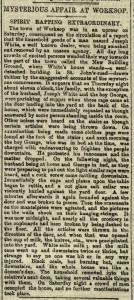October 31, 2014, by Kathryn Steenson
Rapping At My Chamber Door
Happy Hallowe’en! Whether or not you love all things ghostly and ghoulish, I hope you’ll enjoy this report of a poltergeist that we came across in the Nottingham Journal dated 7 March 1883:
 “Mysterious Affair At Worksop. Spirit Rapping Extraordinary.
“Mysterious Affair At Worksop. Spirit Rapping Extraordinary.
The town of Worksop was in uproar on Saturday, consequent on the circulation of a report that the household goods of a man named Joseph White, a well-known dealer, were being smashed and removed by an unseen agency. All day long crowds of excited persons wended their way towards the part of the town called the New Building Ground, where White’s house stands – a semi-detached building in St John’ Road – drawn thither by the exaggerated accounts of the mysterious occurrences. It appears that on Thursday night about eleven o’clock, the family, with the exception of the husband Joseph White and the boy George was partaking of supper when three raps came at the door leading into the yard at the back of the house, which were immediately repeated as though answered by some person standing inside the room. Other noises were heard on the stairs as though certain articles were being thrown down. On examination being made some clothes pegs were found at the foot of the stairs; and next morning the boy George, who was in bed at the time, was charged with endeavouring to frighten the people downstairs. He protested his innocence and the matter dropped. On the following night, the husband being at home and George in bed, as they were preparing to put out the light similar raps were heard, and a cork screw came rattling downstairs. Immediately the cups and plates upon the table began to rattle, and a cut glass salt cellar was violently hurled against the yard door. A few minutes afterwards in again hounded against the door and was broken to pieces. Then the ornaments on the mantelpiece were agitated, and the pictures on the walls shook on their hanging strings. It was now midnight, and nearly all the crockery in the cupboards had been broken by being dashed to the floor. All the articles were thrown in the direction of the door, and when that was opened the cup of milk, the knives etc were precipitated into the yard. White sells milk; and the milk cans went up and downstairs twice or thrice, but strange to say no one was hit or in any way injured. Black coals, but burning hot, came downstairs and the whole house was like a demon’s den. The household removed into the relative’s next door, taking several valuable things with them. On Saturday night a crowd of men occupied the house, and no further manifestations took place.”

The Worksop Poltergeist story features in this pamphlet, alongside Nottingham’s more famous tales of folklore.
From the 1881 and 1891 censuses, this might be the family of Joseph White, a 27-year old General Dealer, who lived with his wife Lydia; their small children Mary, Joseph and George; and Joseph’s younger brothers John (aged 10) and Tom (aged 18). Also staying temporarily in the house was a girl called Eliza Rose. She was, apparently, the child of an ‘imbecile’ mother and considered none-too-bright herself. Her age wasn’t given and she wasn’t with the Whites on the census so I haven’t been able to find out any more about her.
The newspaper’s report didn’t investigate further or propose an alternative explanation (although some people in Worksop suspected Joseph White). The ‘Worksop Poltergeist’ became reasonably famous, and was the subject of an investigation by the newly-formed Society for Psychical Research. Researcher Frank Podmore visited Worksop and published his findings in the “Report on the Worksop Disturbances” in Journal of the Society for Psychical Research issue 1, 1884.
Initially accepting the events were caused by a supernatural force, by 1896 Podmore had changed his mind, due in part to the discrepancies and inconsistencies in the witness accounts. Over the intervening years investigating paranormal phenomena, he realised how unreliable eyewitness testimony is, particularly in untrained observers whose memories are clouded by passage of time, fear, or an unwillingness to believe they’re being deceived.
This isn’t to suggest that the family deliberately made it up. It’s easy to see how innocuous events, such as loud noises disturbing people late at night or poorly-stacked crockery falling, might be linked by a frightened individual. By the time Podmore arrived, five weeks later, the tale had been repeated up and down the streets of Worksop by the Whites and excited neighbours, and printed in several local newspapers. A story of things that go bump in the night becomes exaggerated until burning hot coals are flying around.
Podmore later implied the ‘poltergeist’ was Eliza Rose, although after 13 years admitted it was impossible to prove what happened. She was the only person present for all poltergeist activity, which started shortly after she arrived, and ceased immediately after Joseph White, who always suspected she caused the disturbances, told her to leave.
But that’s not such a good story, is it?
For more information about our holdings, please see the Manuscripts & Special Collections website. For less verbose but equally spooky archive-related tales, read our #ScaryStoriesIn5Words by following us on Twitter @mssUniNott.
No comments yet, fill out a comment to be the first

Leave a Reply